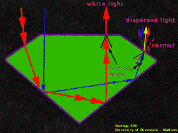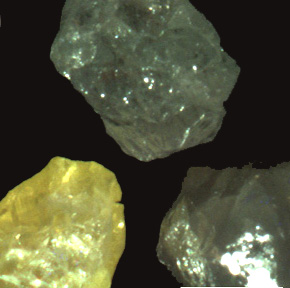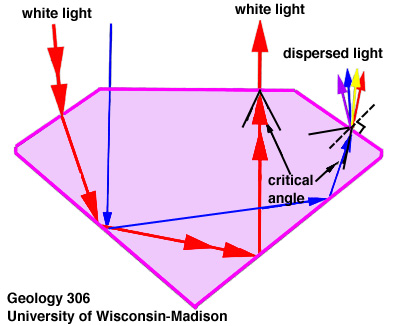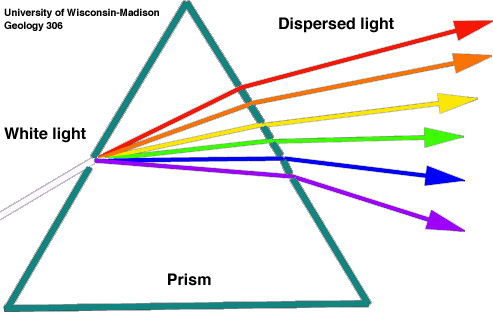WHAT IS A GEM?


Examples include (left to right): coral, amber, and vegetable ivory (tagua nuts)


unlike cut gemstones:

A GEM is a NATURALLY OCCURRING material DESIRABLE for its
BEAUTY, VALUABLE in its RARITY, and sufficiently DURABLE to give lasting pleasure.
A gem should not be easily scratched or broken:
brittleness: tendency to crack and cleave
Diamonds:... Typically a diamond deposit yields about 5g/1000 kg. In
other words, 5 grams per million grams!
The answers to these questions are related. Before we try and answer them, we need to learn some basic terms used to describe cut stones.
Polished planar surfaces are referred to as facets.
Some important terms facet names include:
The term used to describe the type of cut where gems have a flat bottom surface and rounded upper surface is cabochon
REFLECTION AND REFRACTION
In order to understand why gems are faceted, it is essential to understand how light behaves once it passes into a gemstone
Light can either be reflected off a surface or pass through the surface into the new substance.
When light passes from one material into another, it is bent or "refracted". But by how much?
The amount light is bent is determined by the density difference between the gem and air. A measure of the amount light is bent is termed the "refractive index" or 'RI'.
CRITICAL ANGLE
The critical angle is the angle at which total internal reflection is achieved. But
what do we mean by "internal reflection"?
Light travelling through a stone intersects the stone-air surface. If it passes within the critical angle (measured relative to the normal to that surface), it will exit the stone. If it passes outside the critical angle, it will be internally reflected.
We use these facts to determine how facets should be placed in order to control the path of light in a gemstone!
Naturally, in order to achieve brilliance and sparkle, we do NOT want light to escape from the pavillion. We DO want light to escape from the top facets!
Thus, to recap, the placement of facets on a gem is determined using critical angle information, which comes from the refractive index information.
Many gem cuts that meet the basic critical angle requirements can be created.
Two important examples are the "Brilliant Cut" and "Emerald Cut".
LUSTER
Not only does the placement of the facets matter, but the smoothness of the
surface does too.
For this course, we are not concerned about how facets are created in practice. However, take a look here if you are curious!
"Fire" refers to the rainbow-like flashes of color seen in cut stones.
Fire is especially obvious in diamonds. Another example: the
rainbows should be obvious!
Where do these come from?
It is important to realize that the extent to which light is refracted (bent on passing into or out of the gem) is dependent upon the wavelength (color) of the light. Note that blue light is bent more than red light
The phenomenon of different amount of bending of different colored light is referred to as dispersion.
DISPERSION is measured: dispersion = refractive index of violet - refractive index of red light.
Dispersion varies greatly with the mineral type. Lists of dispersion values are available
SUMMARY: the fire of a gem is a consequence of the cut of the stone, coupled
with its dispersion.
Many of the light behaviors we have thought about here (reflection, refraction, dispersion) are commonly observed in everyday life! Excellent examples can be found in the atmosphere.
If we compare two different minerals, for example diamond and quartz (the main i
ngredient in beach sand) we will find that quartz crystals are readily scratched
by diamond but diamonds can not be scratched by quartz. Thus, diamond is much
much harder than quartz.
Commonly available materials can be arranged into a sequence of increasing hard
ness,
e.g., talc-fingernail-copper coin-pocket knife-glass-steel file.
This can also be done with minerals. Moh arranged 10 minerals into a sequence t
hat is known as Moh's hardness scale. This scale has talc (found in talcum powd
er) at the soft end and diamond at the hard end. The hardness of talc is 1, qua
rtz is 7, diamond is 10.
Unfortunately, most minerals with hardness greater than 7 on Moh's hardness s
cale are brittle. Minerals can break by irregular fracture (like bottle glas
s) or by cleaving.
The 4 factors that affect the value of a gemstone:
are easily remembered as the "4 c's":
color, clarity, cut, and carat weight
Color: we will deal with the origin of color in gemstones in a
separate
lecture. Clearly, color affects value. Some colors are more desirable than others. In part, this is dictated by personal taste and in part by industry standards (e.g., for diamonds).
Clarity: flaws (cracks, inclusions) decrease the value of a gemstone
Cut: the ideal proportions for gems (to optimize brilliance and fire) are not always to be found in a faceted stone. Poorly cut stones have much lower value.
Small errors in the placement of facets decrease the value of a gem. For example,
Carat
weight: bigger is not always better, but for otherwise equal color,
clarity, cut, the larger the stone will be more expensive! 1 carat =
0.2 g, thus 5 carat = 1 g <--- remember this! Notice that the number of
carats depends on density, so two different types of gems of the same size
will normally be a different number of carats! Obviously, the
rarity of a gemstone is an important factor in determining the
value. However, some other things that affect value that are unrelated to
the 4c's and rarity. The supply of a specific type of gem can be
controlled to improve the value or a specific gem may greatly change in
value due to consumer demand or perceived investment potential. It is
interesting to look at the values of specific
gemstones and see how these
change over time. The value of a gem may be much lower if its
apparent clarity or color has been improved by treatment. Furthermore,
synthetic gems (made by humans) have very much lower values than natural
stones ... and beware! - the gemstone is not always the material it is
claimed to be: it may be a simulant (look-alike). HOW DO YOU KNOW??
In this course, we will discuss some of the things to look for. Many
people turn to a professional organization such at The Gemological
Institute of America (GIA) and American Gemological Laboratories (AGL) for
the "final" determination, especially for more expensive stones. These
organizations provide certificates that document
the characteristics of individual gems.
OTHER TOOLS:Why do cut gems sparkle?

 Watch these MOVIES to see how this works!
Watch these MOVIES to see how this works!
 FIRE
FIRE
Durability
Value
![]()
 "Where Do Gems Form and Where Are
They Found?"
"Where Do Gems Form and Where Are
They Found?" ![]()
![]()